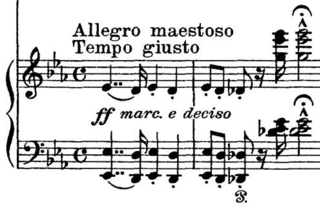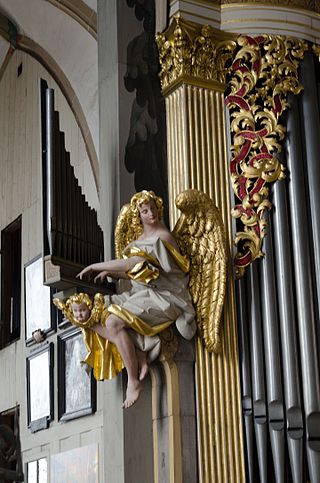Related Research Articles
The Hungarian Rhapsodies, S.244, R.106, are a set of 19 piano pieces based on Hungarian folk themes, composed by Franz Liszt during 1846–1853, and later in 1882 and 1885. Liszt also arranged versions for orchestra, piano duet and piano trio.
D minor is a minor scale based on D, consisting of the pitches D, E, F, G, A, B♭, and C. Its key signature has one flat. Its relative major is F major and its parallel major is D major.

Franz Liszt composed his Piano Concerto No. 1 in E♭ major, S.124 over a 26-year period; the main themes date from 1830, while the final version is dated 1849. The concerto consists of four movements and lasts approximately 20 minutes. It premiered in Weimar on February 17, 1855, with Liszt at the piano and Hector Berlioz conducting.

Hungarian Rhapsody No. 2 in C-sharp minor, S.244/2, is the second in a set of 19 Hungarian Rhapsodies by composer Franz Liszt, published in 1851, and is by far the most famous of the set.

Prelude and Fugue in A minor, BWV 543 is a piece of organ music written by Johann Sebastian Bach sometime around his years as court organist to the Duke of Saxe-Weimar (1708–1713).
Hungarian Rhapsody No. 6 is the sixth work of the 19 Hungarian Rhapsodies composed by Franz Liszt for piano. Liszt composed the piano version in D-flat major. He did not compose orchestral arrangements for any of the Hungarian Rhapsodies.
The three csárdás that Franz Liszt wrote in 1881–82 and 1884 are solo piano pieces based on the Hungarian dance form of the same name. Liszt treats the dance form itself much less freely than he did much earlier with the verbunkos in the Hungarian Rhapsodies, and the material itself remains more specifically Hungarian than gypsy in thematic material. Their spare lines, angular rhythms and advanced harmonies show these pieces to be direct ancestors of the compositions of Béla Bartók. Because of these attributes, the csárdás are considered by Liszt scholars among the more interesting of the composer's late output.
The Fantasia on Hungarian Folk Melodies, commonly known in short form simply as the Hungarian Fantasy, is Franz Liszt's arrangement for piano and orchestra of his Hungarian Rhapsody No. 14, originally for solo piano. The Fantasia was written in 1852 and premiered in Pest on June 1, 1853, with Hans von Bülow as soloist and Ferenc Erkel conducting the orchestra.

Hungarian Rhapsody No. 19 (S.244/19) in D minor is the last of a set of 19 Hungarian Rhapsodies by the Hungarian composer Franz Liszt. It was written in 1885.
Hungarian Rhapsody No. 10 in E major, S.244/10, is a composition for solo piano by Franz Liszt. It is tenth in the set of his Hungarian Rhapsodies, and is subtitled Preludio, although this name is not commonly used. It, along with the rest of the first fifteen rhapsodies, were published in 1853.
Hungarian Rhapsody No. 3, S.244/3, in B-flat major, is the third in a set of nineteen Hungarian Rhapsodies composed by Franz Liszt for solo piano. The rhapsody has an earlier version, like many other of Liszt's compositions: its Andante music appeared in No. 11 in the set of 21 pieces of the Magyar Dalok (1839–1847). It was composed in 1847 and published in 1853.
Hungarian Rhapsody No. 8, S.244/8, in F-sharp minor, is the eighth Hungarian Rhapsody composed by Franz Liszt for solo piano. It was composed in 1847 and published in 1853. It has been nicknamed "Capriccio". It utilizes a melody of Hungarian folk song Káka tövén költ a ruca in the slow section. The allegro motif was also used by Liszt in his symphonic poem Hungaria (1856).
Hungarian Rhapsody No. 9, S.244/9, in E-flat major, is the ninth Hungarian Rhapsody by Franz Liszt. It is nicknamed the "Carnival in Pest" or "Pesther Carneval" and was composed in 1847. A typical performance of the piece lasts ten minutes.

Hungarian Rhapsody No. 11, S.244/11, in A minor, is the eleventh Hungarian Rhapsody by Franz Liszt. An average performance of the piece lasts about five minutes.
Hungarian Rhapsody No. 13, S.244/13, in A minor, is the thirteenth Hungarian Rhapsody by Franz Liszt. One of the lesser performed works of Liszt, the friska section starts with a theme used by the well-known Allegro molto vivace from Zigeunerweisen by Pablo de Sarasate. At the end, it quotes the authentic Hungarian folk song Nem, nem, nem, nem megyünk mi innen el.
Hungarian Rhapsody No. 15, subtitled Rákóczi March, S.244/15, in A minor, is the fifteenth Hungarian Rhapsody by Franz Liszt. Written in 1853, the rhapsody is based on the Rákóczi March. An average performance of the piece lasts around six minutes.
Hungarian Rhapsody No. 16, S.244/16, in A minor is the sixteenth Hungarian Rhapsody composed by Franz Liszt for solo piano. It was composed and published in 1882. The rhapsody, subtitled Budapest Munkácsy-Festlichkeiten, has a duration of approximately five minutes and is dedicated to Mihály Munkácsy. It was arranged for piano four-hands by the composer himself, marked as S.622, published in the same year. The piece begins with an outset of the main theme, A Minor, but with a distinct ambiguity of tonality. This section ends with a cadenza. The following section introduces a new theme, marked Lassan Langsam, and also ends with a cadenza. The third section is a repeat of the second section, but transposed to B-flat Minor. The fourth section of the piece repeats the theme from the first section and segues to the Friska of the piece, marked Allegro con Brio. This introduces the parallel major to A Minor as the tonic and continues with lively variations on the first theme. The piece concludes with octaves ascending the keyboard in A Major arpeggios and is finished on four final A Major chords.
Hungarian Rhapsody No. 17, S.244/17, in D minor, is the seventeenth Hungarian Rhapsody composed by Franz Liszt for solo piano. It was composed and published in 1882. This piece and the eighteenth rhapsody are the shortest of the Hungarian Rhapsodies, each having a duration of just over three minutes.
Hungarian Rhapsody No. 18, S.244/18, in F-sharp minor, is the eighteenth Hungarian Rhapsody composed by Franz Liszt for solo piano. An average performance of the piece lasts three minutes. Along with its predecessor, the seventeenth rhapsody, it is the shortest Hungarian Rhapsody of the set. This rhapsody is subtitled Ungarische Ausstellung in Budapest.
The Consolations are a set of six solo piano works by Franz Liszt. The compositions take the musical style of Nocturnes with each having its own distinctive style. Each Consolation is composed in either the key of E major or D♭ major. E major is a key regularly used by Liszt for religious themes.
References
- ↑ Cummings, Robert. "Hungarian Rhapsody, for piano No. 14 in F minor, S. 244/14 (LW A132/14)". AllMusic. Retrieved 2012-03-28.